Evaluating the Macroeconomic Factors Affecting Airline Profitability
VerifiedAdded on 2023/06/03
|7
|2019
|184
Report
AI Summary
This report provides a macro-level analysis of the airline industry, focusing on the impact of rising fuel costs and labor expenses on profitability in 2018. It examines the influence of global oil prices, production cuts by OPEC, and increasing labor demands on airline operations. The report highlights how airlines are adapting to these challenges, including adjusting ticket prices and suspending flights. Despite these headwinds, the aviation industry has experienced growth due to new markets, technological advancements, and strategic fuel stocking. The analysis concludes that while the industry remains relatively stable, the long-term effects of rising costs could alter its financial landscape. Desklib offers a wealth of resources, including past papers and solved assignments, to aid students in their studies.
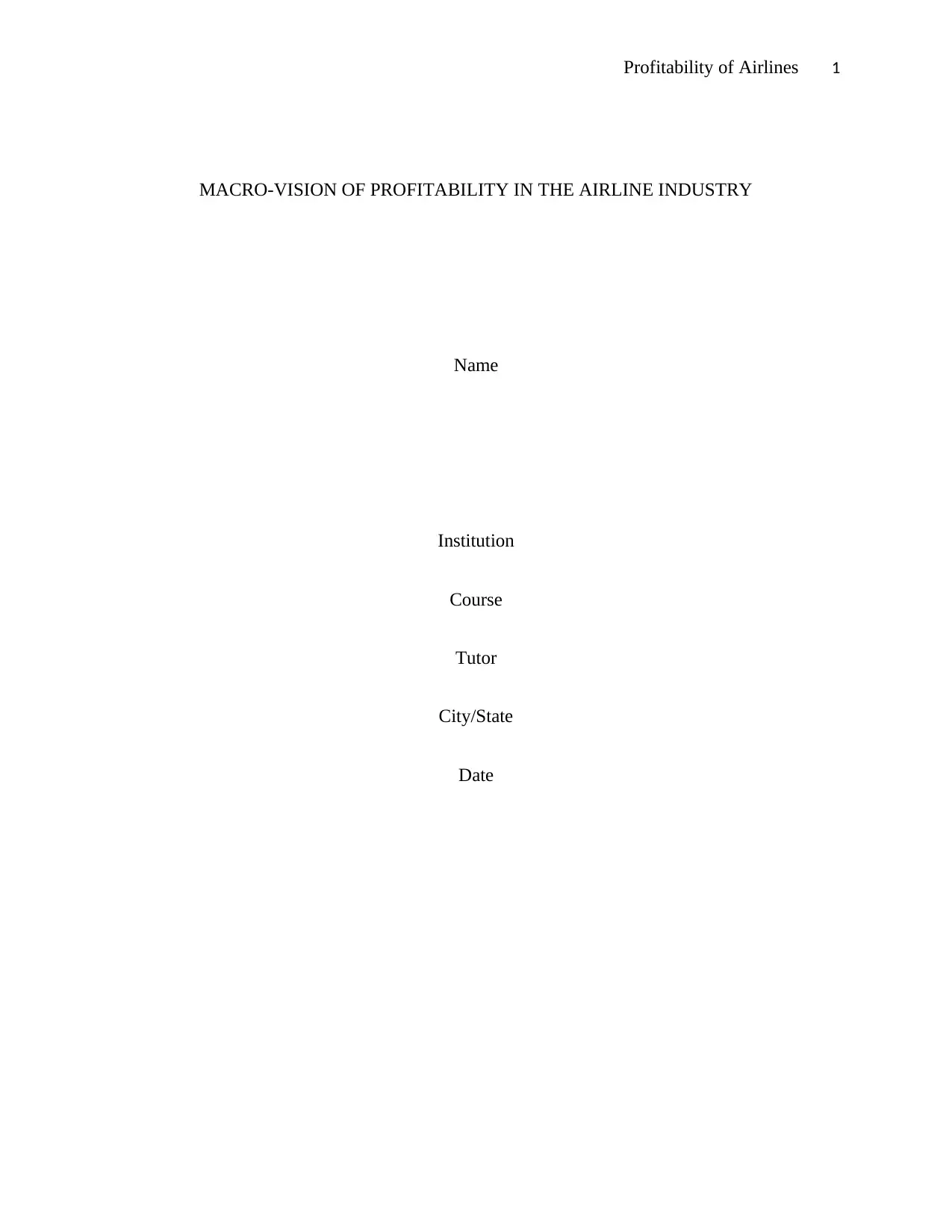
Profitability of Airlines 1
MACRO-VISION OF PROFITABILITY IN THE AIRLINE INDUSTRY
Name
Institution
Course
Tutor
City/State
Date
MACRO-VISION OF PROFITABILITY IN THE AIRLINE INDUSTRY
Name
Institution
Course
Tutor
City/State
Date
Paraphrase This Document
Need a fresh take? Get an instant paraphrase of this document with our AI Paraphraser
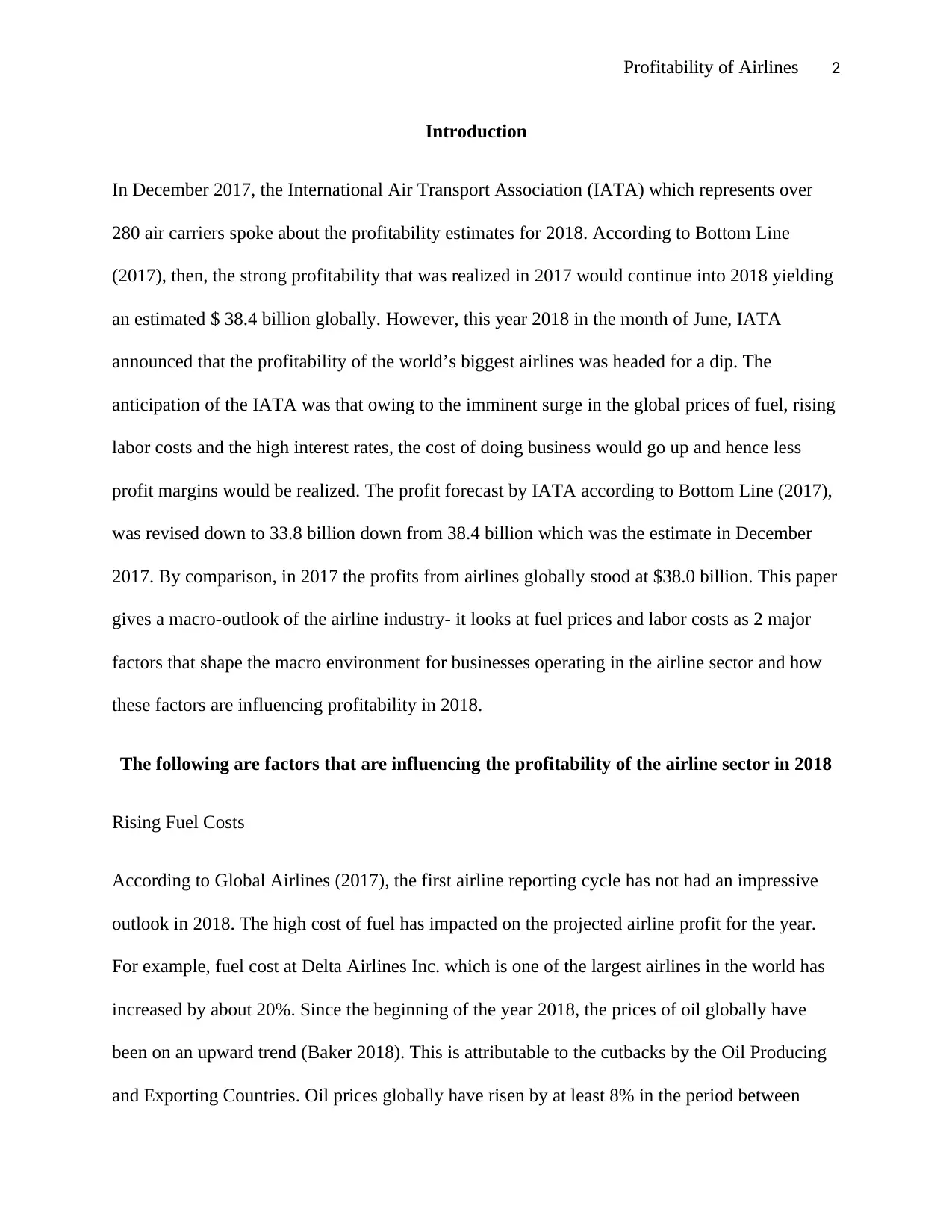
Profitability of Airlines 2
Introduction
In December 2017, the International Air Transport Association (IATA) which represents over
280 air carriers spoke about the profitability estimates for 2018. According to Bottom Line
(2017), then, the strong profitability that was realized in 2017 would continue into 2018 yielding
an estimated $ 38.4 billion globally. However, this year 2018 in the month of June, IATA
announced that the profitability of the world’s biggest airlines was headed for a dip. The
anticipation of the IATA was that owing to the imminent surge in the global prices of fuel, rising
labor costs and the high interest rates, the cost of doing business would go up and hence less
profit margins would be realized. The profit forecast by IATA according to Bottom Line (2017),
was revised down to 33.8 billion down from 38.4 billion which was the estimate in December
2017. By comparison, in 2017 the profits from airlines globally stood at $38.0 billion. This paper
gives a macro-outlook of the airline industry- it looks at fuel prices and labor costs as 2 major
factors that shape the macro environment for businesses operating in the airline sector and how
these factors are influencing profitability in 2018.
The following are factors that are influencing the profitability of the airline sector in 2018
Rising Fuel Costs
According to Global Airlines (2017), the first airline reporting cycle has not had an impressive
outlook in 2018. The high cost of fuel has impacted on the projected airline profit for the year.
For example, fuel cost at Delta Airlines Inc. which is one of the largest airlines in the world has
increased by about 20%. Since the beginning of the year 2018, the prices of oil globally have
been on an upward trend (Baker 2018). This is attributable to the cutbacks by the Oil Producing
and Exporting Countries. Oil prices globally have risen by at least 8% in the period between
Introduction
In December 2017, the International Air Transport Association (IATA) which represents over
280 air carriers spoke about the profitability estimates for 2018. According to Bottom Line
(2017), then, the strong profitability that was realized in 2017 would continue into 2018 yielding
an estimated $ 38.4 billion globally. However, this year 2018 in the month of June, IATA
announced that the profitability of the world’s biggest airlines was headed for a dip. The
anticipation of the IATA was that owing to the imminent surge in the global prices of fuel, rising
labor costs and the high interest rates, the cost of doing business would go up and hence less
profit margins would be realized. The profit forecast by IATA according to Bottom Line (2017),
was revised down to 33.8 billion down from 38.4 billion which was the estimate in December
2017. By comparison, in 2017 the profits from airlines globally stood at $38.0 billion. This paper
gives a macro-outlook of the airline industry- it looks at fuel prices and labor costs as 2 major
factors that shape the macro environment for businesses operating in the airline sector and how
these factors are influencing profitability in 2018.
The following are factors that are influencing the profitability of the airline sector in 2018
Rising Fuel Costs
According to Global Airlines (2017), the first airline reporting cycle has not had an impressive
outlook in 2018. The high cost of fuel has impacted on the projected airline profit for the year.
For example, fuel cost at Delta Airlines Inc. which is one of the largest airlines in the world has
increased by about 20%. Since the beginning of the year 2018, the prices of oil globally have
been on an upward trend (Baker 2018). This is attributable to the cutbacks by the Oil Producing
and Exporting Countries. Oil prices globally have risen by at least 8% in the period between
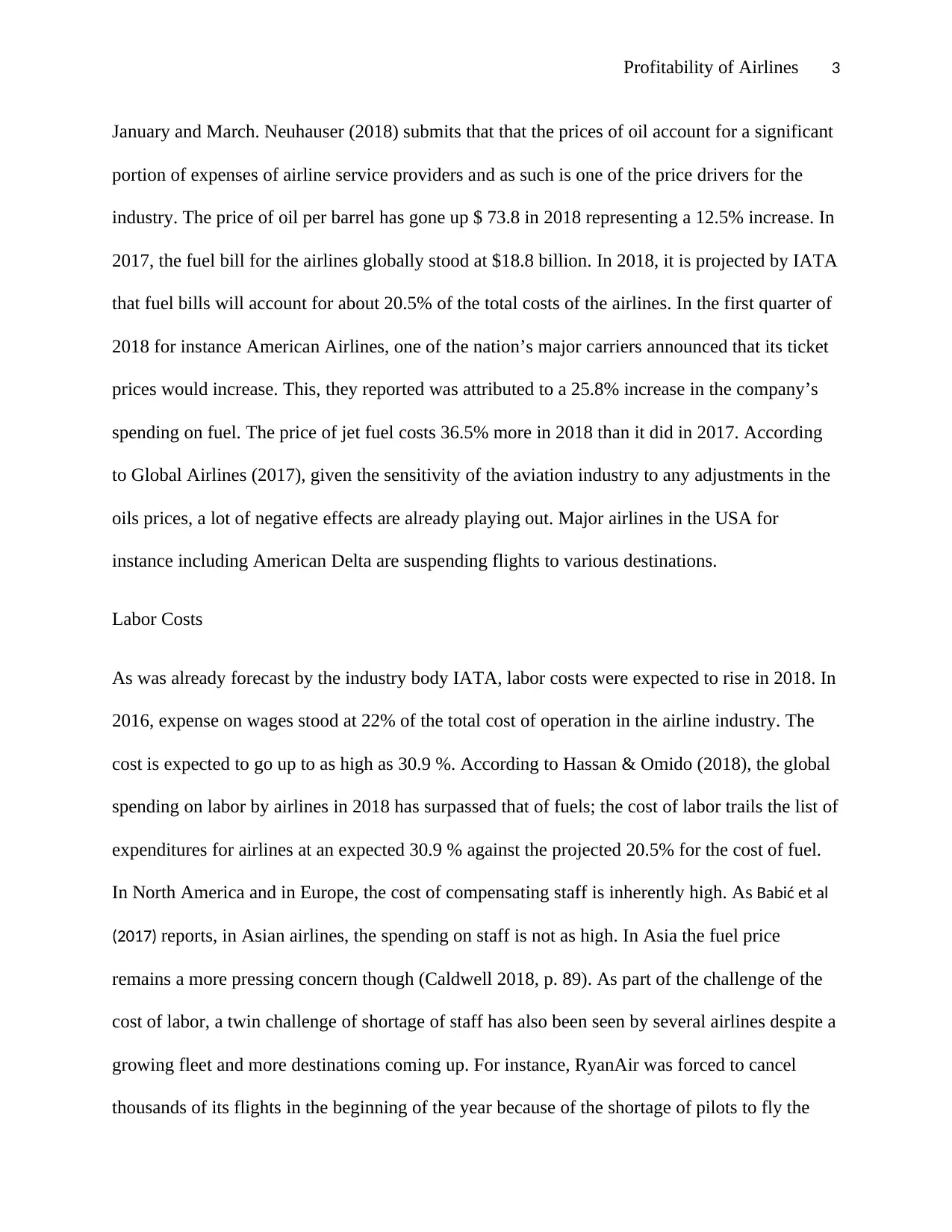
Profitability of Airlines 3
January and March. Neuhauser (2018) submits that that the prices of oil account for a significant
portion of expenses of airline service providers and as such is one of the price drivers for the
industry. The price of oil per barrel has gone up $ 73.8 in 2018 representing a 12.5% increase. In
2017, the fuel bill for the airlines globally stood at $18.8 billion. In 2018, it is projected by IATA
that fuel bills will account for about 20.5% of the total costs of the airlines. In the first quarter of
2018 for instance American Airlines, one of the nation’s major carriers announced that its ticket
prices would increase. This, they reported was attributed to a 25.8% increase in the company’s
spending on fuel. The price of jet fuel costs 36.5% more in 2018 than it did in 2017. According
to Global Airlines (2017), given the sensitivity of the aviation industry to any adjustments in the
oils prices, a lot of negative effects are already playing out. Major airlines in the USA for
instance including American Delta are suspending flights to various destinations.
Labor Costs
As was already forecast by the industry body IATA, labor costs were expected to rise in 2018. In
2016, expense on wages stood at 22% of the total cost of operation in the airline industry. The
cost is expected to go up to as high as 30.9 %. According to Hassan & Omido (2018), the global
spending on labor by airlines in 2018 has surpassed that of fuels; the cost of labor trails the list of
expenditures for airlines at an expected 30.9 % against the projected 20.5% for the cost of fuel.
In North America and in Europe, the cost of compensating staff is inherently high. As Babić et al
(2017) reports, in Asian airlines, the spending on staff is not as high. In Asia the fuel price
remains a more pressing concern though (Caldwell 2018, p. 89). As part of the challenge of the
cost of labor, a twin challenge of shortage of staff has also been seen by several airlines despite a
growing fleet and more destinations coming up. For instance, RyanAir was forced to cancel
thousands of its flights in the beginning of the year because of the shortage of pilots to fly the
January and March. Neuhauser (2018) submits that that the prices of oil account for a significant
portion of expenses of airline service providers and as such is one of the price drivers for the
industry. The price of oil per barrel has gone up $ 73.8 in 2018 representing a 12.5% increase. In
2017, the fuel bill for the airlines globally stood at $18.8 billion. In 2018, it is projected by IATA
that fuel bills will account for about 20.5% of the total costs of the airlines. In the first quarter of
2018 for instance American Airlines, one of the nation’s major carriers announced that its ticket
prices would increase. This, they reported was attributed to a 25.8% increase in the company’s
spending on fuel. The price of jet fuel costs 36.5% more in 2018 than it did in 2017. According
to Global Airlines (2017), given the sensitivity of the aviation industry to any adjustments in the
oils prices, a lot of negative effects are already playing out. Major airlines in the USA for
instance including American Delta are suspending flights to various destinations.
Labor Costs
As was already forecast by the industry body IATA, labor costs were expected to rise in 2018. In
2016, expense on wages stood at 22% of the total cost of operation in the airline industry. The
cost is expected to go up to as high as 30.9 %. According to Hassan & Omido (2018), the global
spending on labor by airlines in 2018 has surpassed that of fuels; the cost of labor trails the list of
expenditures for airlines at an expected 30.9 % against the projected 20.5% for the cost of fuel.
In North America and in Europe, the cost of compensating staff is inherently high. As Babić et al
(2017) reports, in Asian airlines, the spending on staff is not as high. In Asia the fuel price
remains a more pressing concern though (Caldwell 2018, p. 89). As part of the challenge of the
cost of labor, a twin challenge of shortage of staff has also been seen by several airlines despite a
growing fleet and more destinations coming up. For instance, RyanAir was forced to cancel
thousands of its flights in the beginning of the year because of the shortage of pilots to fly the
⊘ This is a preview!⊘
Do you want full access?
Subscribe today to unlock all pages.

Trusted by 1+ million students worldwide
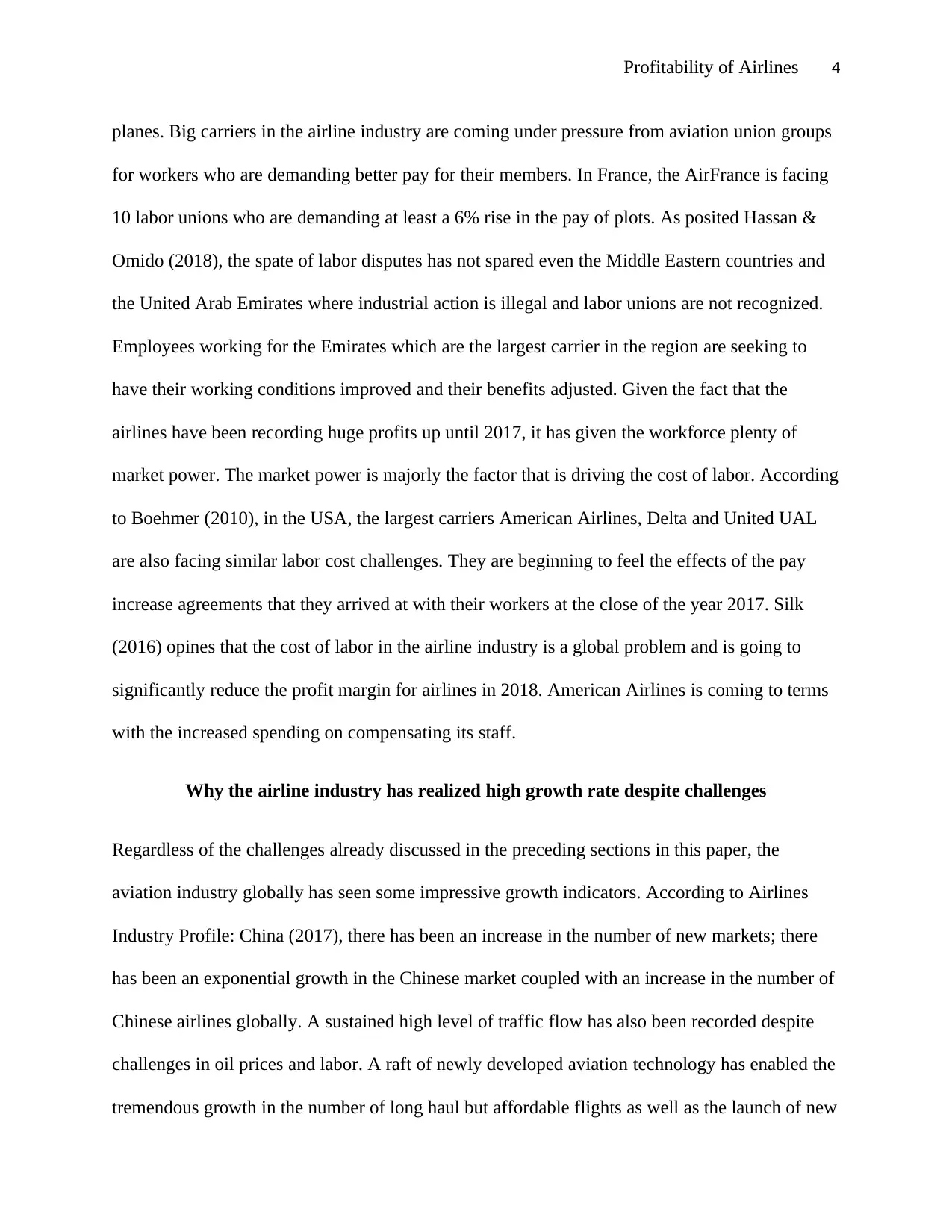
Profitability of Airlines 4
planes. Big carriers in the airline industry are coming under pressure from aviation union groups
for workers who are demanding better pay for their members. In France, the AirFrance is facing
10 labor unions who are demanding at least a 6% rise in the pay of plots. As posited Hassan &
Omido (2018), the spate of labor disputes has not spared even the Middle Eastern countries and
the United Arab Emirates where industrial action is illegal and labor unions are not recognized.
Employees working for the Emirates which are the largest carrier in the region are seeking to
have their working conditions improved and their benefits adjusted. Given the fact that the
airlines have been recording huge profits up until 2017, it has given the workforce plenty of
market power. The market power is majorly the factor that is driving the cost of labor. According
to Boehmer (2010), in the USA, the largest carriers American Airlines, Delta and United UAL
are also facing similar labor cost challenges. They are beginning to feel the effects of the pay
increase agreements that they arrived at with their workers at the close of the year 2017. Silk
(2016) opines that the cost of labor in the airline industry is a global problem and is going to
significantly reduce the profit margin for airlines in 2018. American Airlines is coming to terms
with the increased spending on compensating its staff.
Why the airline industry has realized high growth rate despite challenges
Regardless of the challenges already discussed in the preceding sections in this paper, the
aviation industry globally has seen some impressive growth indicators. According to Airlines
Industry Profile: China (2017), there has been an increase in the number of new markets; there
has been an exponential growth in the Chinese market coupled with an increase in the number of
Chinese airlines globally. A sustained high level of traffic flow has also been recorded despite
challenges in oil prices and labor. A raft of newly developed aviation technology has enabled the
tremendous growth in the number of long haul but affordable flights as well as the launch of new
planes. Big carriers in the airline industry are coming under pressure from aviation union groups
for workers who are demanding better pay for their members. In France, the AirFrance is facing
10 labor unions who are demanding at least a 6% rise in the pay of plots. As posited Hassan &
Omido (2018), the spate of labor disputes has not spared even the Middle Eastern countries and
the United Arab Emirates where industrial action is illegal and labor unions are not recognized.
Employees working for the Emirates which are the largest carrier in the region are seeking to
have their working conditions improved and their benefits adjusted. Given the fact that the
airlines have been recording huge profits up until 2017, it has given the workforce plenty of
market power. The market power is majorly the factor that is driving the cost of labor. According
to Boehmer (2010), in the USA, the largest carriers American Airlines, Delta and United UAL
are also facing similar labor cost challenges. They are beginning to feel the effects of the pay
increase agreements that they arrived at with their workers at the close of the year 2017. Silk
(2016) opines that the cost of labor in the airline industry is a global problem and is going to
significantly reduce the profit margin for airlines in 2018. American Airlines is coming to terms
with the increased spending on compensating its staff.
Why the airline industry has realized high growth rate despite challenges
Regardless of the challenges already discussed in the preceding sections in this paper, the
aviation industry globally has seen some impressive growth indicators. According to Airlines
Industry Profile: China (2017), there has been an increase in the number of new markets; there
has been an exponential growth in the Chinese market coupled with an increase in the number of
Chinese airlines globally. A sustained high level of traffic flow has also been recorded despite
challenges in oil prices and labor. A raft of newly developed aviation technology has enabled the
tremendous growth in the number of long haul but affordable flights as well as the launch of new
Paraphrase This Document
Need a fresh take? Get an instant paraphrase of this document with our AI Paraphraser
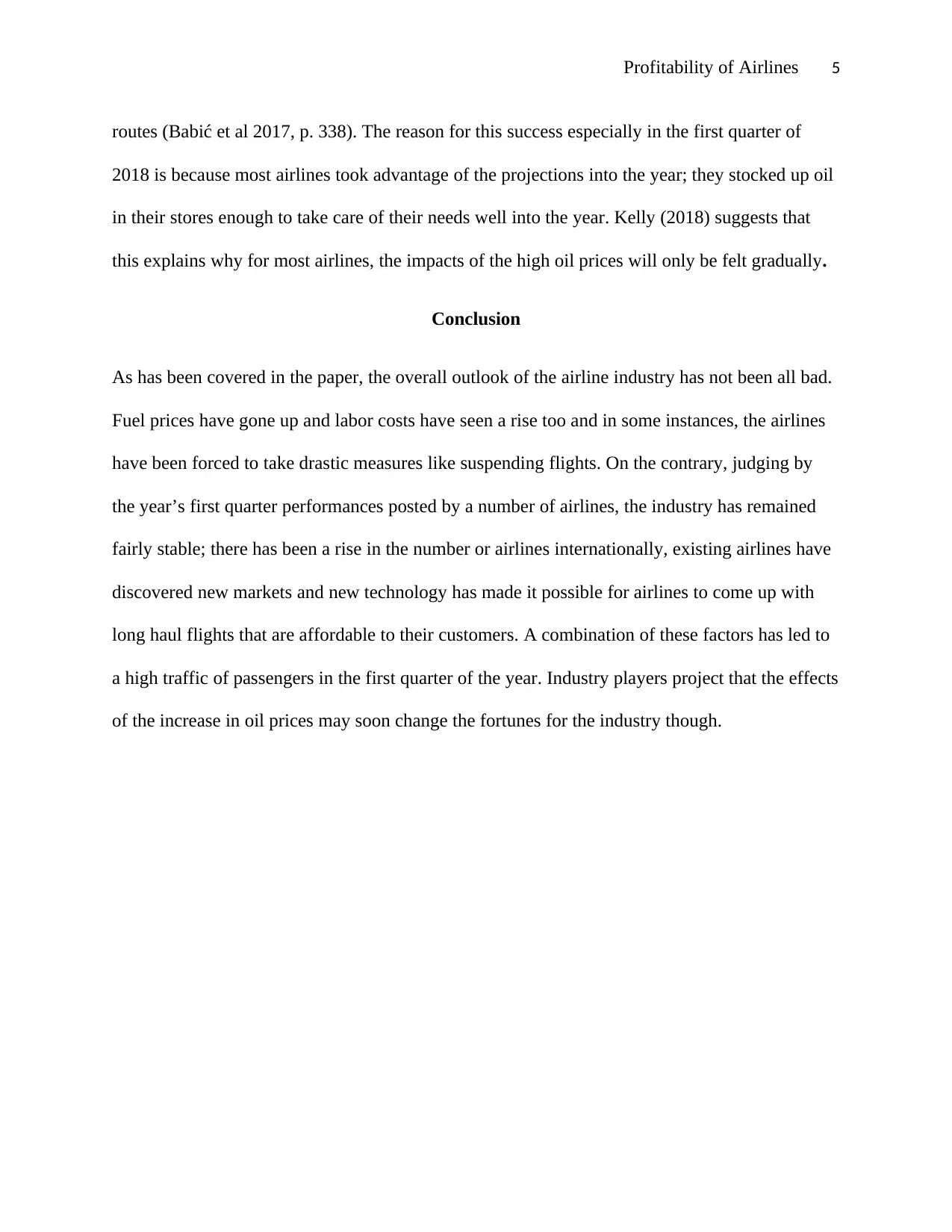
Profitability of Airlines 5
routes (Babić et al 2017, p. 338). The reason for this success especially in the first quarter of
2018 is because most airlines took advantage of the projections into the year; they stocked up oil
in their stores enough to take care of their needs well into the year. Kelly (2018) suggests that
this explains why for most airlines, the impacts of the high oil prices will only be felt gradually.
Conclusion
As has been covered in the paper, the overall outlook of the airline industry has not been all bad.
Fuel prices have gone up and labor costs have seen a rise too and in some instances, the airlines
have been forced to take drastic measures like suspending flights. On the contrary, judging by
the year’s first quarter performances posted by a number of airlines, the industry has remained
fairly stable; there has been a rise in the number or airlines internationally, existing airlines have
discovered new markets and new technology has made it possible for airlines to come up with
long haul flights that are affordable to their customers. A combination of these factors has led to
a high traffic of passengers in the first quarter of the year. Industry players project that the effects
of the increase in oil prices may soon change the fortunes for the industry though.
routes (Babić et al 2017, p. 338). The reason for this success especially in the first quarter of
2018 is because most airlines took advantage of the projections into the year; they stocked up oil
in their stores enough to take care of their needs well into the year. Kelly (2018) suggests that
this explains why for most airlines, the impacts of the high oil prices will only be felt gradually.
Conclusion
As has been covered in the paper, the overall outlook of the airline industry has not been all bad.
Fuel prices have gone up and labor costs have seen a rise too and in some instances, the airlines
have been forced to take drastic measures like suspending flights. On the contrary, judging by
the year’s first quarter performances posted by a number of airlines, the industry has remained
fairly stable; there has been a rise in the number or airlines internationally, existing airlines have
discovered new markets and new technology has made it possible for airlines to come up with
long haul flights that are affordable to their customers. A combination of these factors has led to
a high traffic of passengers in the first quarter of the year. Industry players project that the effects
of the increase in oil prices may soon change the fortunes for the industry though.
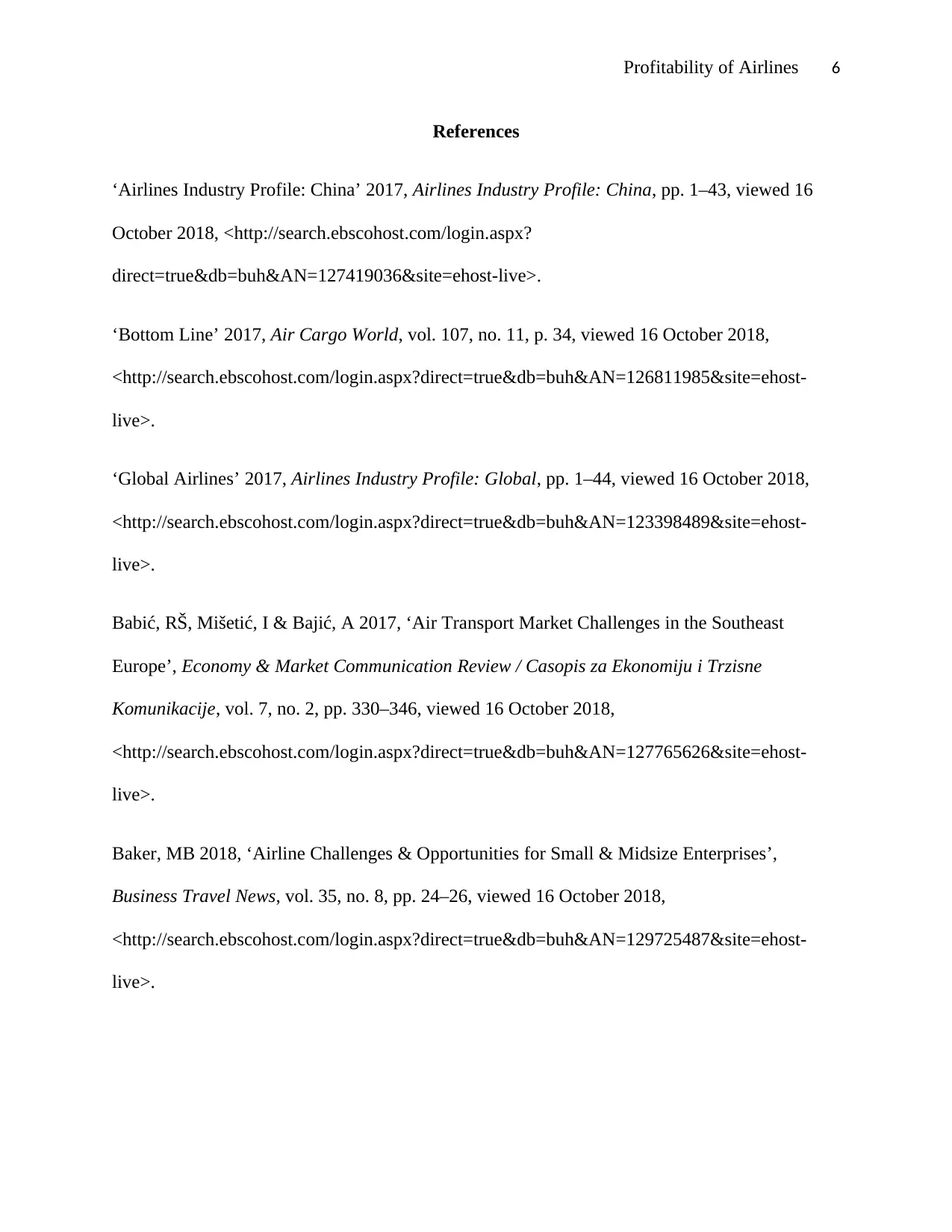
Profitability of Airlines 6
References
‘Airlines Industry Profile: China’ 2017, Airlines Industry Profile: China, pp. 1–43, viewed 16
October 2018, <http://search.ebscohost.com/login.aspx?
direct=true&db=buh&AN=127419036&site=ehost-live>.
‘Bottom Line’ 2017, Air Cargo World, vol. 107, no. 11, p. 34, viewed 16 October 2018,
<http://search.ebscohost.com/login.aspx?direct=true&db=buh&AN=126811985&site=ehost-
live>.
‘Global Airlines’ 2017, Airlines Industry Profile: Global, pp. 1–44, viewed 16 October 2018,
<http://search.ebscohost.com/login.aspx?direct=true&db=buh&AN=123398489&site=ehost-
live>.
Babić, RŠ, Mišetić, I & Bajić, A 2017, ‘Air Transport Market Challenges in the Southeast
Europe’, Economy & Market Communication Review / Casopis za Ekonomiju i Trzisne
Komunikacije, vol. 7, no. 2, pp. 330–346, viewed 16 October 2018,
<http://search.ebscohost.com/login.aspx?direct=true&db=buh&AN=127765626&site=ehost-
live>.
Baker, MB 2018, ‘Airline Challenges & Opportunities for Small & Midsize Enterprises’,
Business Travel News, vol. 35, no. 8, pp. 24–26, viewed 16 October 2018,
<http://search.ebscohost.com/login.aspx?direct=true&db=buh&AN=129725487&site=ehost-
live>.
References
‘Airlines Industry Profile: China’ 2017, Airlines Industry Profile: China, pp. 1–43, viewed 16
October 2018, <http://search.ebscohost.com/login.aspx?
direct=true&db=buh&AN=127419036&site=ehost-live>.
‘Bottom Line’ 2017, Air Cargo World, vol. 107, no. 11, p. 34, viewed 16 October 2018,
<http://search.ebscohost.com/login.aspx?direct=true&db=buh&AN=126811985&site=ehost-
live>.
‘Global Airlines’ 2017, Airlines Industry Profile: Global, pp. 1–44, viewed 16 October 2018,
<http://search.ebscohost.com/login.aspx?direct=true&db=buh&AN=123398489&site=ehost-
live>.
Babić, RŠ, Mišetić, I & Bajić, A 2017, ‘Air Transport Market Challenges in the Southeast
Europe’, Economy & Market Communication Review / Casopis za Ekonomiju i Trzisne
Komunikacije, vol. 7, no. 2, pp. 330–346, viewed 16 October 2018,
<http://search.ebscohost.com/login.aspx?direct=true&db=buh&AN=127765626&site=ehost-
live>.
Baker, MB 2018, ‘Airline Challenges & Opportunities for Small & Midsize Enterprises’,
Business Travel News, vol. 35, no. 8, pp. 24–26, viewed 16 October 2018,
<http://search.ebscohost.com/login.aspx?direct=true&db=buh&AN=129725487&site=ehost-
live>.
⊘ This is a preview!⊘
Do you want full access?
Subscribe today to unlock all pages.

Trusted by 1+ million students worldwide
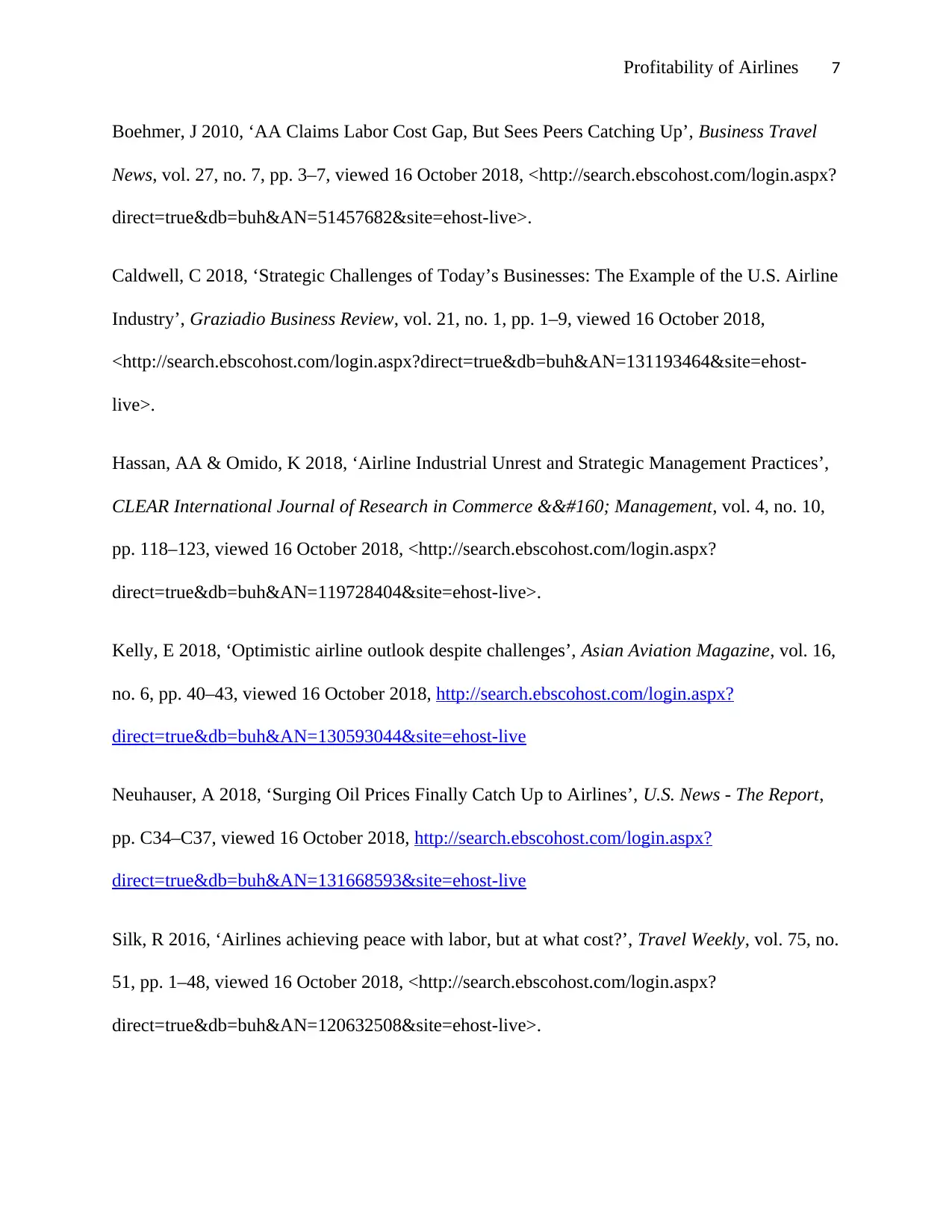
Profitability of Airlines 7
Boehmer, J 2010, ‘AA Claims Labor Cost Gap, But Sees Peers Catching Up’, Business Travel
News, vol. 27, no. 7, pp. 3–7, viewed 16 October 2018, <http://search.ebscohost.com/login.aspx?
direct=true&db=buh&AN=51457682&site=ehost-live>.
Caldwell, C 2018, ‘Strategic Challenges of Today’s Businesses: The Example of the U.S. Airline
Industry’, Graziadio Business Review, vol. 21, no. 1, pp. 1–9, viewed 16 October 2018,
<http://search.ebscohost.com/login.aspx?direct=true&db=buh&AN=131193464&site=ehost-
live>.
Hassan, AA & Omido, K 2018, ‘Airline Industrial Unrest and Strategic Management Practices’,
CLEAR International Journal of Research in Commerce &  Management, vol. 4, no. 10,
pp. 118–123, viewed 16 October 2018, <http://search.ebscohost.com/login.aspx?
direct=true&db=buh&AN=119728404&site=ehost-live>.
Kelly, E 2018, ‘Optimistic airline outlook despite challenges’, Asian Aviation Magazine, vol. 16,
no. 6, pp. 40–43, viewed 16 October 2018, http://search.ebscohost.com/login.aspx?
direct=true&db=buh&AN=130593044&site=ehost-live
Neuhauser, A 2018, ‘Surging Oil Prices Finally Catch Up to Airlines’, U.S. News - The Report,
pp. C34–C37, viewed 16 October 2018, http://search.ebscohost.com/login.aspx?
direct=true&db=buh&AN=131668593&site=ehost-live
Silk, R 2016, ‘Airlines achieving peace with labor, but at what cost?’, Travel Weekly, vol. 75, no.
51, pp. 1–48, viewed 16 October 2018, <http://search.ebscohost.com/login.aspx?
direct=true&db=buh&AN=120632508&site=ehost-live>.
Boehmer, J 2010, ‘AA Claims Labor Cost Gap, But Sees Peers Catching Up’, Business Travel
News, vol. 27, no. 7, pp. 3–7, viewed 16 October 2018, <http://search.ebscohost.com/login.aspx?
direct=true&db=buh&AN=51457682&site=ehost-live>.
Caldwell, C 2018, ‘Strategic Challenges of Today’s Businesses: The Example of the U.S. Airline
Industry’, Graziadio Business Review, vol. 21, no. 1, pp. 1–9, viewed 16 October 2018,
<http://search.ebscohost.com/login.aspx?direct=true&db=buh&AN=131193464&site=ehost-
live>.
Hassan, AA & Omido, K 2018, ‘Airline Industrial Unrest and Strategic Management Practices’,
CLEAR International Journal of Research in Commerce &  Management, vol. 4, no. 10,
pp. 118–123, viewed 16 October 2018, <http://search.ebscohost.com/login.aspx?
direct=true&db=buh&AN=119728404&site=ehost-live>.
Kelly, E 2018, ‘Optimistic airline outlook despite challenges’, Asian Aviation Magazine, vol. 16,
no. 6, pp. 40–43, viewed 16 October 2018, http://search.ebscohost.com/login.aspx?
direct=true&db=buh&AN=130593044&site=ehost-live
Neuhauser, A 2018, ‘Surging Oil Prices Finally Catch Up to Airlines’, U.S. News - The Report,
pp. C34–C37, viewed 16 October 2018, http://search.ebscohost.com/login.aspx?
direct=true&db=buh&AN=131668593&site=ehost-live
Silk, R 2016, ‘Airlines achieving peace with labor, but at what cost?’, Travel Weekly, vol. 75, no.
51, pp. 1–48, viewed 16 October 2018, <http://search.ebscohost.com/login.aspx?
direct=true&db=buh&AN=120632508&site=ehost-live>.
1 out of 7
Related Documents
Your All-in-One AI-Powered Toolkit for Academic Success.
+13062052269
info@desklib.com
Available 24*7 on WhatsApp / Email
![[object Object]](/_next/static/media/star-bottom.7253800d.svg)
Unlock your academic potential
Copyright © 2020–2025 A2Z Services. All Rights Reserved. Developed and managed by ZUCOL.





